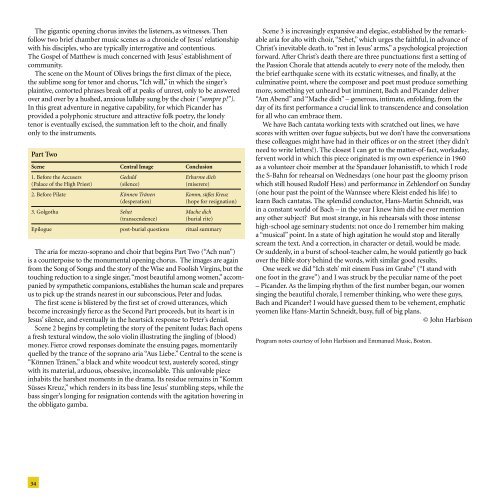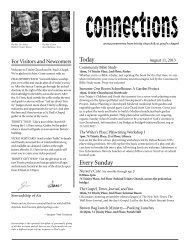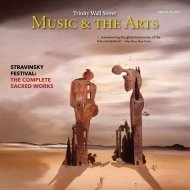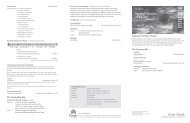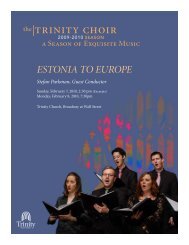Create successful ePaper yourself
Turn your PDF publications into a flip-book with our unique Google optimized e-Paper software.
The gigantic opening chorus invites <strong>the</strong> listeners, as witnesses. Then<br />
follow two brief chamber music scenes as a chronicle of Jesus’ relationship<br />
with his disciples, who are typically interrogative and contentious.<br />
The Gospel of Mat<strong>the</strong>w is much concerned with Jesus’ establishment of<br />
community.<br />
The scene on <strong>the</strong> Mount of Olives brings <strong>the</strong> first climax of <strong>the</strong> piece,<br />
<strong>the</strong> sublime song for tenor and chorus, “Ich will,” in which <strong>the</strong> singer’s<br />
plaintive, contorted phrases break off at peaks of unrest, only to be answered<br />
over and over by a hushed, anxious lullaby sung by <strong>the</strong> choir (“sempre p!”).<br />
In this great adventure in negative capability, for which Picander has<br />
provided a polyphonic structure and attractive folk poetry, <strong>the</strong> lonely<br />
tenor is eventually excised, <strong>the</strong> summation left to <strong>the</strong> choir, and finally<br />
only to <strong>the</strong> instruments.<br />
Part Two<br />
Scene Central Image Conclusion<br />
1. Before <strong>the</strong> Accusers Geduld Erbarme dich<br />
(Palace of <strong>the</strong> High Priest) (silence) (miserere)<br />
2. Before Pilate Können Tränen Komm, süßes Kreuz<br />
(desperation) (hope for resignation)<br />
3. Golgotha Sehet Mache dich<br />
(transcendence) (burial rite)<br />
Epilogue post-burial questions ritual summary<br />
The aria for mezzo-soprano and choir that begins Part Two (“Ach nun”)<br />
is a counterpoise to <strong>the</strong> monumental opening chorus. The images are again<br />
from <strong>the</strong> Song of Songs and <strong>the</strong> story of <strong>the</strong> Wise and Foolish Virgins, but <strong>the</strong><br />
touching reduction to a single singer, “most beautiful among women,” accompanied<br />
by sympa<strong>the</strong>tic companions, establishes <strong>the</strong> human scale and prepares<br />
us to pick up <strong>the</strong> strands nearest in our subconscious, Peter and Judas.<br />
The first scene is blistered by <strong>the</strong> first set of crowd utterances, which<br />
become increasingly fierce as <strong>the</strong> Second Part proceeds, but its heart is in<br />
Jesus’ silence, and eventually in <strong>the</strong> heartsick response to Peter’s denial.<br />
Scene 2 begins by completing <strong>the</strong> story of <strong>the</strong> penitent Judas; Bach opens<br />
a fresh textural window, <strong>the</strong> solo violin illustrating <strong>the</strong> jingling of (blood)<br />
money. Fierce crowd responses dominate <strong>the</strong> ensuing pages, momentarily<br />
quelled by <strong>the</strong> trance of <strong>the</strong> soprano aria “Aus Liebe.” Central to <strong>the</strong> scene is<br />
“Können Tränen,” a black and white woodcut text, austerely scored, stingy<br />
with its material, arduous, obsessive, inconsolable. This unlovable piece<br />
inhabits <strong>the</strong> harshest moments in <strong>the</strong> drama. Its residue remains in “Komm<br />
Süsses Kreuz,” which renders in its bass line Jesus’ stumbling steps, while <strong>the</strong><br />
bass singer’s longing for resignation contends with <strong>the</strong> agitation hovering in<br />
<strong>the</strong> obbligato gamba.<br />
34<br />
Scene 3 is increasingly expansive and elegiac, established by <strong>the</strong> remarkable<br />
aria for alto with choir, “Sehet,” which urges <strong>the</strong> faithful, in advance of<br />
Christ’s inevitable death, to “rest in Jesus’ arms,” a psychological projection<br />
forward. After Christ’s death <strong>the</strong>re are three punctuations: first a setting of<br />
<strong>the</strong> Passion Chorale that attends acutely to every note of <strong>the</strong> melody, <strong>the</strong>n<br />
<strong>the</strong> brief earthquake scene with its ecstatic witnesses, and finally, at <strong>the</strong><br />
culminative point, where <strong>the</strong> composer and poet must produce something<br />
more, something yet unheard but imminent, Bach and Picander deliver<br />
“Am Abend” and “Mache dich” – generous, intimate, enfolding, from <strong>the</strong><br />
day of its first performance a crucial link to transcendence and consolation<br />
for all who can embrace <strong>the</strong>m.<br />
We have Bach cantata working texts with scratched out lines, we have<br />
scores with written over fugue subjects, but we don’t have <strong>the</strong> conversations<br />
<strong>the</strong>se colleagues might have had in <strong>the</strong>ir offices or on <strong>the</strong> street (<strong>the</strong>y didn’t<br />
need to write letters!). The closest I can get to <strong>the</strong> matter-of-fact, workaday,<br />
fervent world in which this piece originated is my own experience in 1960<br />
as a volunteer choir member at <strong>the</strong> Spandauer Johanisstift, to which I rode<br />
<strong>the</strong> S-Bahn for rehearsal on Wednesdays (one hour past <strong>the</strong> gloomy prison<br />
which still housed Rudolf Hess) and performance in Zehlendorf on Sunday<br />
(one hour past <strong>the</strong> point of <strong>the</strong> Wannsee where Kleist ended his life) to<br />
learn Bach cantatas. The splendid conductor, Hans-Martin Schneidt, was<br />
in a constant world of Bach – in <strong>the</strong> year I knew him did he ever mention<br />
any o<strong>the</strong>r subject? But most strange, in his rehearsals with those intense<br />
high-school age seminary students: not once do I remember him making<br />
a “musical” point. In a state of high agitation he would stop and literally<br />
scream <strong>the</strong> text. And a correction, in character or detail, would be made.<br />
Or suddenly, in a burst of school-teacher calm, he would patiently go back<br />
over <strong>the</strong> Bible story behind <strong>the</strong> words, with similar good results.<br />
One week we did “Ich steh’ mit einem Fuss im Grabe” (“I stand with<br />
one foot in <strong>the</strong> grave”) and I was struck by <strong>the</strong> peculiar name of <strong>the</strong> poet<br />
– Picander. As <strong>the</strong> limping rhythm of <strong>the</strong> first number began, our women<br />
singing <strong>the</strong> beautiful chorale, I remember thinking, who were <strong>the</strong>se guys,<br />
Bach and Picander? I would have guessed <strong>the</strong>m to be vehement, emphatic<br />
yeomen like Hans-Martin Schneidt, busy, full of big plans.<br />
© John Harbison<br />
Program notes courtesy of John Harbison and Emmanuel <strong>Music</strong>, Boston.


